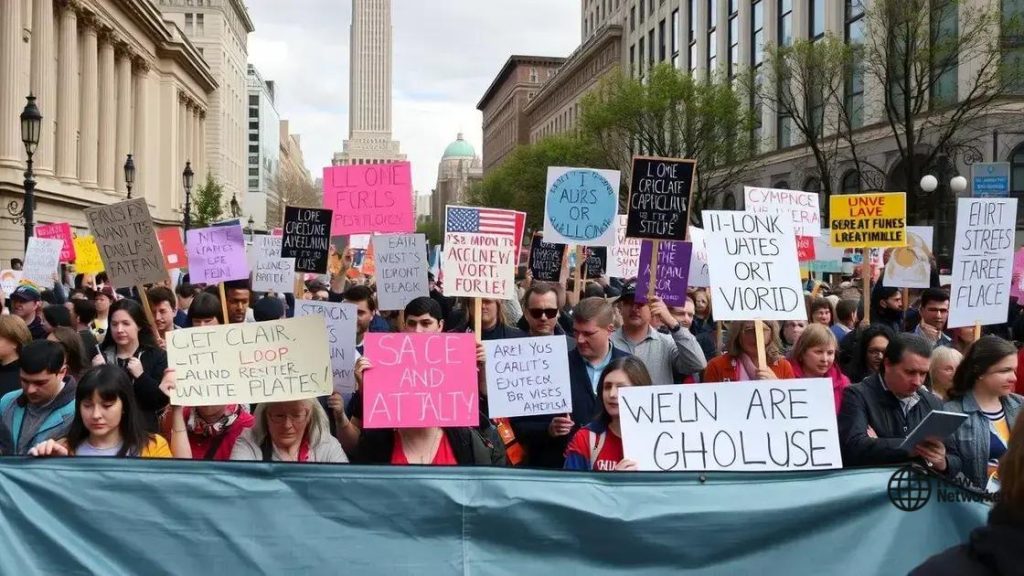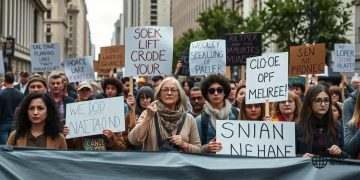Policy reforms driven by civic demonstrations: exploring impacts

Policy reforms driven by civic demonstrations can lead to increased accountability, inclusivity, and collaboration, significantly impacting governance and societal change.
Policy reforms driven by civic demonstrations have reshaped societies worldwide. What leads citizens to rally for change, and how do these movements spark significant reforms? Here, we delve into the dynamic relationship between civic action and policy shifts.
Understanding civic demonstrations and their motives
Civic demonstrations play a crucial role in shaping public policy. They are often driven by a strong desire for change, reflecting the voices of citizens who seek to address social issues. Understanding the motives behind these protests is essential to grasp their impact.
A myriad of factors contribute to the emergence of civic demonstrations. Many participants feel a deep sense of injustice, motivating them to gather and make their demands heard. Economic inequality, systemic discrimination, and lack of governmental accountability are common triggers for such movements.
Key Motivations for Civic Demonstrations
People join demonstrations for various reasons:
- Desire for Change: Many attendees are passionate about specific issues and want to see meaningful reforms.
- Community Solidarity: Civic demonstrations foster a sense of belonging and support among participants, strengthening community ties.
- Awareness Raising: Protests often aim to inform the public and raise awareness about pressing social issues.
- Political Pressure: Demonstrations can pressure policymakers to act, leading to changes in laws and regulations.
Notably, different groups may have unique motives. For instance, youth-led protests often focus on climate change, while marginalized communities may rally against systemic racism. These differences highlight the diverse perspectives within civic demonstrations.
The influence of social media cannot be overlooked. Platforms like Twitter and Facebook amplify messages and help organize protests quickly. This modern method of mobilization allows groups to spread their motives and goals far and wide.
In summary, understanding civic demonstrations requires examining both the individual and collective motivations that inspire people to take to the streets. These protests are more than just gatherings; they represent a critical dialogue between citizens and their governments.
Key historical examples of successful policy reforms
Throughout history, several civic demonstrations have led to significant policy reforms. These events often showcased the power of collective action and the ability of citizens to drive change. By examining these historical instances, we can learn how movements have shaped policies and societies.
One key example is the Civil Rights Movement in the United States during the 1950s and 1960s. Activists organized peaceful protests to challenge racial injustice and demand equal rights. The culmination of these efforts led to landmark legislation, such as the Civil Rights Act of 1964 and the Voting Rights Act of 1965, which helped dismantle legalized segregation and protect voting rights.
Other Historical Examples
There are several noteworthy instances where civic demonstrations spurred policy change:
- Women’s Suffrage Movement: Women’s protests for voting rights in the early 20th century ultimately led to the passage of the 19th Amendment in 1920, granting women the right to vote.
- Anti-Apartheid Movement: Global protests against apartheid in South Africa helped dismantle oppressive laws and led to the election of Nelson Mandela in 1994.
- Protests for Climate Action: Recent demonstrations, particularly by youth-led groups, have pushed governments worldwide to address climate change through policy reforms and international agreements.
These examples illustrate how civic demonstrations can effectively influence government actions and policies. They highlight the vital role that public pressure plays in shaping legislation. Beyond the immediate changes, these movements have inspired ongoing activism, proving that citizens can indeed impact their governance.
As societies evolve, these historical examples serve as reminders of the effectiveness of peaceful protest in enacting policy change. They encourage current and future generations to engage in civic participation to foster a better society.
The role of social media in mobilizing protests

Social media plays a vital role in mobilizing protests. It provides a platform for individuals to share information quickly and connect with others who share their concerns. This instant communication has transformed the way civic demonstrations are organized and executed.
One significant advantage of social media is its ability to reach a large audience in a short amount of time. Activists can post updates, share event details, and offer real-time information about protests. This has led to the rapid mobilization of supporters and the organization of mass gatherings.
How Social Media Fuels Protests
Several factors demonstrate how social media impacts civic demonstrations:
- Awareness and Education: Social media helps raise awareness about critical issues. By sharing videos, articles, and images, activists educate the public on the reasons behind protests.
- Accessibility: Platforms like Twitter, Facebook, and Instagram make it easy for anyone to participate, regardless of location. This inclusivity helps amplify voices that might otherwise go unheard.
- Community Building: Social media creates communities of like-minded individuals. These connections foster solidarity and support among activists, encouraging more participation.
- Real-Time Updates: During protests, platforms allow attendees to share updates instantly, enhancing safety and coordination among participants.
The impact of social media can be seen in various movements around the globe. For example, the Arab Spring utilized platforms like Facebook and Twitter to organize protests against oppressive regimes. Similarly, the Black Lives Matter movement gained momentum through hashtags and viral posts that highlighted systemic racism.
Despite its positive impact, social media also poses challenges. Misinformation can spread quickly, leading to confusion and miscommunication among protestors. Activists must be cautious and ensure their messages are clear and factual.
Challenges faced by activists after demonstrations
After demonstrations, activists often encounter various challenges that can impact their movements. These obstacles can be physical, emotional, or logistical, and understanding them is crucial for sustained advocacy.
One major challenge is maintaining momentum. After a protest, keeping participants engaged and focused on the cause can be difficult. Activists need to develop strategies to ensure that the issues remain in the public eye.
Common Challenges Faced by Activists
Several key issues arise following civic demonstrations:
- Repression and Crackdowns: In many cases, authorities respond to protests with increased surveillance or law enforcement actions, which can intimidate activists.
- Public Fatigue: After a major event, the public’s interest may wane, making it challenging to sustain activism and push for policy changes.
- Internal Division: Movements can face splits or disagreements among their members, making unified action harder.
- Resource Limitations: Activists often rely on limited funding and volunteer support, which can hinder long-term planning and operations.
In addition to these difficulties, many activists experience emotional tolls. The pressure of activism can lead to burnout, stress, and feelings of isolation. The ongoing battle for social justice can feel overwhelming, especially when progress seems slow or challenging. Support networks are crucial in combating these feelings.
Moreover, activists must navigate the complexities of communication. Crafting compelling messages, organizing events, and dealing with the media are all essential skills in the aftermath of protests. Effective communication can re-engage supporters and attract new allies.
Future implications of civic engagement on policy
The future of civic engagement is crucial for shaping public policy. As more people become involved in advocacy, the impact on governance will likely grow stronger. The increasing accessibility of information means that citizens can mobilize more effectively than ever before.
One significant implication of enhanced civic engagement is the potential for greater accountability. When more individuals participate in the political process, elected officials are pressured to listen to their constituents. This accountability can lead to more responsive policies that reflect the needs of the community.
Key Future Implications
Several future implications of civic engagement on policy include:
- Increased Participation: As digital platforms evolve, more citizens will engage in discussions and actions regarding policy issues.
- Collaboration Across Sectors: Future civic engagement may see collaborations between activists, governments, and private sectors, leading to innovative solutions.
- Emphasis on Inclusivity: Movements will likely demand that marginalized voices are included in policy discussions, leading to more equitable outcomes.
- Shifts in Political Norms: The growing power of civic engagement could change how political campaigns and policymaking operate, making them more transparent and participatory.
Moreover, as civic engagement becomes more widespread, younger generations will play a critical role in advocating for issues like climate change and social justice. Their passion for change will continue to drive policy discussions and motivate others to join the cause.
While challenges remain, such as misinformation and political polarization, the overall trend points toward a more engaged citizenry. As individuals come together for common causes, the potential for meaningful policy reform increases. This dynamic landscape requires policymakers to adapt and engage with constituents in new ways.
FAQ – Frequently Asked Questions about Civic Engagement and Policy Reforms
What is civic engagement?
Civic engagement is the participation of individuals in activities that advocate for social or political change, such as voting, protests, or community activism.
How does social media influence civic engagement?
Social media facilitates faster communication and mobilization, helping activists share information and organize protests effectively.
What challenges do activists face after protests?
Activists may encounter issues like maintaining momentum, repression from authorities, and emotional stress, which can impact their efforts.
Why is inclusivity important in civic engagement?
Inclusivity ensures that marginalized voices are heard in policy discussions, leading to more equitable and just outcomes for all community members.





